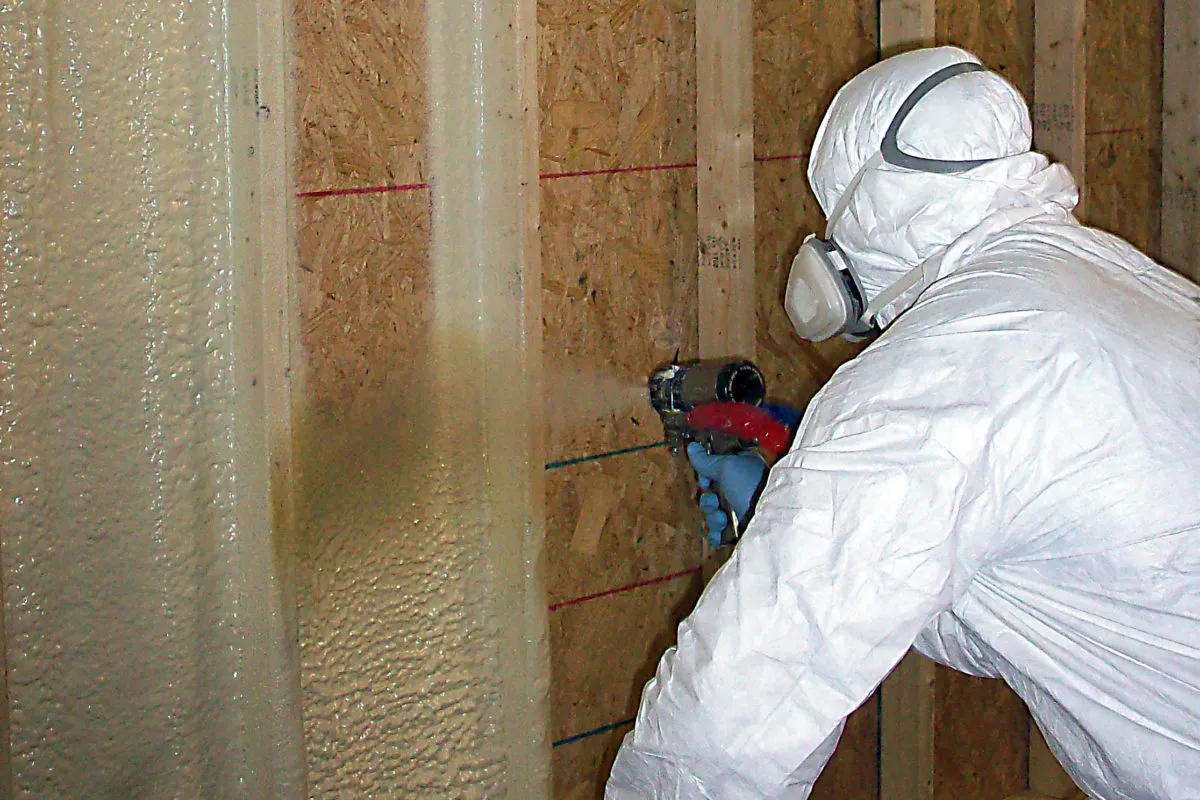If you’re considering spray foam insulation for your property in Rochester, MN you might wonder, “Is 2 inches of closed-cell foam enough?” Insulation is crucial in maintaining energy efficiency, comfort, and moisture control, whether you’re dealing with a home, a commercial building, or an agricultural facility. Closed-cell foam insulation, known for its density and high R-value, is widespread. But determining how much is “enough” is not always straightforward.
This post will help you determine whether 2 inches of closed-cell foam insulation is adequate for your needs in Rochester, MN. It will cover each property type’s benefits, limitations, and considerations.
What Is Closed-Cell Spray Foam?
Closed-cell spray foam insulation is a high-density polyurethane material that expands upon application to form an effective thermal, moisture, and air barrier. Unlike its counterpart, open-cell foam, closed-cell foam has tightly packed cells, making it rigid and far more moisture-resistant. It has an impressive R-value, typically ranging between R-6.5 to R-7 per inch, offering superior insulation to many other materials.
But while closed-cell foam excels at insulating properties, deciding how much to use depends on specific factors like climate, the type of building, and your overall energy efficiency goals. Let’s examine whether 2 inches is adequate for homes, businesses, and farms in Rochester, MN.
Residential Insulation: Is 2 Inches of Closed-Cell Foam Enough?
Climate Considerations in Rochester, MN
Like much of Minnesota, Rochester, MN’s climate has extreme temperature variations, frigid winters, and hot, humid summers. These conditions require an insulation solution that performs well in both cold and heat. Given its high R-value and impermeability to moisture, closed-cell foam insulation is an excellent choice, but the question remains: Is 2 inches enough?
R-Value Needs for Homes
For residential properties, the recommended R-value in attics and walls by the US Department of Energy is R-49 for attics and R-13 to R-21 for exterior walls in Minnesota’s climate zone. With an R-value of roughly R-6.5 to R-7 per inch, 2 inches of closed-cell foam would only offer an R-value of around R-13 to R-14—which is enough for specific applications, such as insulating walls. However, achieving R-49 with closed-cell foam would require closer to 7 inches in attics, far more than just 2 inches.
Where 2 Inches Works Well in Homes
- Exterior Walls: Two inches of closed-cell foam can insulate exterior walls, especially if you pair it with other materials, such as batt insulation. It creates an effective air seal, drastically reducing drafts and improving comfort.
- Basements and Crawl Spaces: In areas prone to moisture, like basements and crawl spaces, 2 inches of closed-cell foam is often sufficient. It provides excellent moisture resistance, preventing mold growth and keeping these areas dry.
When You Need More
More than two inches of closed-cell foam is generally needed in attics and ceilings. Attics are prone to large temperature swings, requiring a higher R-value for maximum efficiency and comfort. Combining closed-cell foam with another insulation type—such as blown-in attic insulation—may be ideal.
Commercial Insulation: Meeting Energy Efficiency Needs
How Commercial Buildings Differ
Commercial buildings often have different insulation requirements compared to homes. Factors such as building size, occupancy, and heating/cooling loads mean that insulation needs must be tailored specifically to the building type.
Benefits of 2 Inches of Closed-Cell Foam for Commercial Spaces
- Moisture Control: For commercial buildings in Rochester, MN, 2 inches of closed-cell foam can provide an effective moisture barrier, crucial for preventing mold and maintaining indoor air quality. This is particularly important for structures like retail shops and office buildings.
- Air Sealing: A significant advantage of closed-cell foam in commercial settings is its ability to form an air barrier. Two inches is often enough to seal cracks, gaps, and other areas where air leaks may occur, which helps lower energy costs.
When More Insulation Might Be Needed
While 2 inches can offer adequate moisture and air control, many commercial structures may require higher R-values to meet energy code requirements. For external walls or roofs, achieving these R-values will often necessitate adding more than just 2 inches or using a hybrid insulation system.
Agricultural Insulation: Protecting Barns and Storage Facilities
Unique Needs of Agricultural Buildings
Agricultural properties in Rochester, MN, such as barns, livestock facilities, and equipment storage areas, have unique insulation needs. Temperature and moisture control are critical for animal health, crop storage, and equipment maintenance.
2 Inches of Closed-Cell Foam for Agricultural Use
- Livestock Comfort: For agricultural buildings, 2 inches of closed-cell foam can effectively control temperatures and reduce drafts, which is beneficial for livestock health. The moisture resistance also helps prevent condensation that can lead to mold and mildew, which is harmful to animals and stored materials.
- Storage Areas: Maintaining a stable temperature is essential for keeping equipment in good condition in storage facilities. Two inches of insulation may suffice to create an adequate barrier against temperature fluctuations, especially if combined with other insulation.
Considerations for More Insulation
If you need to store temperature-sensitive products like grains or need to protect livestock during the coldest months, you may need more than 2 inches of insulation. In such cases, adding more foam or combining it with another type of insulation could ensure the necessary level of climate control.
The Advantages and Limitations of 2 Inches of Closed-Cell Foam
Advantages
- Air Barrier: Two inches of closed-cell spray foam provides an excellent air barrier, effectively sealing gaps, cracks, and spaces where air could otherwise escape.
- Moisture Resistance: The foam is impervious to moisture, which prevents mold growth and protects the integrity of your building structure.
- Structural Rigidity: Closed-cell foam adds rigidity to walls, enhancing the structural integrity of homes and other buildings.
Limitations
- R-Value Limitation: While 2 inches provides a decent R-value (R-13 to R-14), it often falls short of what’s needed for optimal energy efficiency, particularly in attics and roofing applications.
- Cost Considerations: Closed-cell foam is one of the more expensive insulation options, so using only 2 inches can be cost-effective, but additional inches can add up quickly.
When Is 2 Inches of Closed-Cell Foam the Right Choice?
Two inches of closed-cell foam insulation is an excellent choice for:
- Basement Walls and Crawl Spaces: It’s enough to manage moisture and keep these areas dry and mold-free.
- Exterior Walls of Residential Homes: This type of insulation is effective for energy efficiency when paired with another kind.
- Commercial Air Sealing: Perfect for sealing cracks and gaps, reducing air leaks, and improving energy efficiency in commercial buildings.
Let Foam Worx Insulation Help You Make the Right Choice
Determining the correct insulation thickness for your property can be challenging, especially when balancing cost, energy efficiency, and comfort. At Foam Worx Insulation, we understand Rochester, MN’s unique climate and insulation needs for residential, commercial, and agricultural properties.
Our experienced team is ready to help you decide if 2 inches of closed-cell foam is enough for your space or if a different approach would better serve your goals. We pride ourselves on providing reliable, professional service and using high-quality materials to enhance the comfort and efficiency of your property.
Contact us today if you’re ready to make your property more energy-efficient or have questions about closed-cell spray foam insulation. Call us at (507) 407-6688, visit our website at https://foamworxinsulation.com/, or email us at [email protected]. Let’s ensure your property is perfectly insulated, whether with 2 inches of closed-cell foam or more. We’re here to help you create the comfortable, energy-efficient space you deserve.
FREQUENTLY ASKED QUESTIONS
1. Is 2 inches of closed-cell spray foam enough for my home in Rochester, MN?
Two inches may be enough for walls and moisture-prone areas like basements, but attics usually require more for optimal insulation.
2. Can 2 inches of closed-cell foam effectively insulate my commercial building?
Yes, for air sealing and moisture control, but additional insulation may be needed to meet energy code requirements.
3. Is 2 inches of closed-cell foam suitable for barns or agricultural buildings?
It works well for reducing drafts and controlling moisture, but more insulation may be needed for temperature-sensitive storage.
4. What are the benefits of using 2 inches of closed-cell foam insulation?
It provides good air-sealing moisture resistance and adds structural strength, though it may only sometimes achieve the highest R-value needed.





